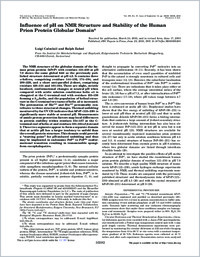Influence of pH on NMR structure and stability of the human prion protein globular domain.
- Calzolai L Institut für Molekularbiologie und Biophysik, Eidgenössische Technische Hochschule Hönggerberg, CH-8093 Zürich, Switzerland. luigi@mol.biol.ethz.ch
- Zahn R
- 2003-06-27
Published in:
- The Journal of biological chemistry. - 2003
Amino Acid Sequence
Drug Stability
Humans
Hydrogen-Ion Concentration
Magnetic Resonance Spectroscopy
Models, Molecular
Peptide Fragments
Prions
Protein Conformation
Recombinant Proteins
English
The NMR structure of the globular domain of the human prion protein (hPrP) with residues 121-230 at pH 7.0 shows the same global fold as the previously published structure determined at pH 4.5. It contains three alpha-helices, comprising residues 144-156, 174-194, and 200-228, and a short anti-parallel beta-sheet, comprising residues 128-131 and 161-164. There are slight, strictly localized, conformational changes at neutral pH when compared with acidic solution conditions: helix alpha1 is elongated at the C-terminal end with residues 153-156 forming a 310-helix, and the population of helical structure in the C-terminal two turns of helix alpha 2 is increased. The protonation of His155 and His187 presumably contributes to these structural changes. Thermal unfolding monitored by far UV CD indicates that hPrP-(121-230) is significantly more stable at neutral pH. Measurements of amide proton protection factors map local differences in protein stability within residues 154-157 at the C-terminal end of helix alpha 1 and residues 161-164 of beta-strand 2. These two segments appear to form a separate domain that at acidic pH has a larger tendency to unfold than the overall protein structure. This domain could provide a "starting point" for pH-induced unfolding and thus may be implicated in endosomic PrPC to PrPSc conformational transition resulting in transmissible spongiform encephalopathies.
- Language
-
- English
- Open access status
- bronze
- Identifiers
-
- DOI 10.1074/jbc.M303005200
- PMID 12826672
- Persistent URL
- https://folia.unifr.ch/global/documents/163954
Statistics
Document views: 8
File downloads:
- Full-text: 0
